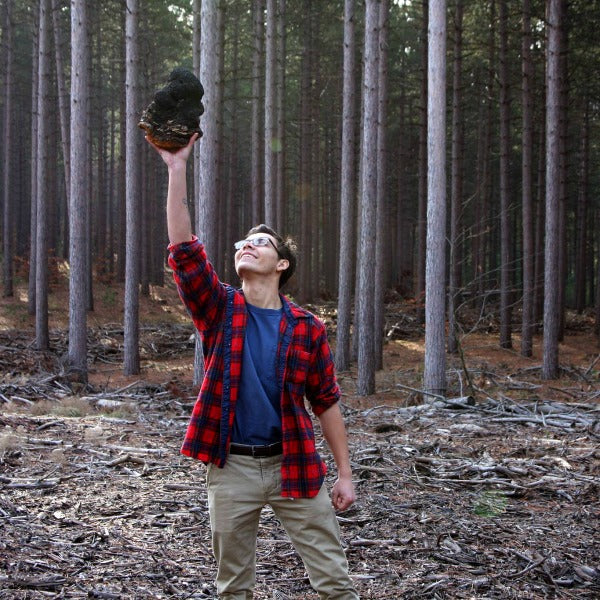Garrett Kopp, founder of The Birch Boys, holding chaga mushrooms. Photo: The Birch Boys
In the forests of the Adirondacks, you can find row upon row of gangly birch trees, the bark of which is white and peels easily like old wallpaper. If you look closely at one, you might be able to see an ugly chunk, larger than other discolorations, protruding out of that bark like a burl of charcoal. If you were to take a hatchet and cut open this gnarled, black canker, its inside would be bright orange-brown and cork-like in texture. This is the chaga mushroom. Or at least it is the sterile conk that develops when a birch tree is deeply infected with the fungus Inonotus obliquus.
Garrett Kopp, barely into his 20s, is the founder of Birch Boys, a company located in the Adirondacks that is dedicated to spreading the use and benefits of chaga. Garrett first came across chaga by accident. As a teenager, he went into his grandmother’s fridge to find a cool drink after mowing her lawn. He picked a black, opaque liquid he assumed was iced tea. But it tasted very mild, just slightly earthy with a hint of sweetness, and definitely not the tea he expected. His grandmother found him and began laughing at what he was drinking. She had made the tea from the chaga she’d found on a birch tree at the end of her yard.
His curiosity over chaga grew and grew until he knew everything about it. The unsightly chaga mushroom has, for centuries, been reputed to have vast therapeutic qualities. It is purported to contribute an array of health benefits, from boosting the immune system to helping regulate cardiovascular function. Chaga needs to grow on birch trees, and grows best in a semi-arctic climate. The Adirondacks are, therefore, a perfect environment for finding and harvesting wild chaga.

Chaga on birch tree. Photo: The Birch Boys
Many legends, often of dubious origin, persist about the mushroom but there are a few things that can be known with some certainty. The name for the fungus is of Russian origin. It comes from inhabitants of Western Siberia called the Khanty, who made tea with it to help their general well-being. In Russia, chaga has a far more storied history. There are records of chaga’s use in folk medicine that go back to the 16th Century.
The idea of chaga as a versatile cure-all is quite common in some parts of Russian culture. So much so that in the novel Cancer Ward by Aleksandr Solzhenitsyn, the protagonist, Oleg Kostoglotov, recounts the story of the chaga mushroom being drunk as tea by peasants too poor to afford real tea, who inadvertently and miraculously cure themselves of cancer.
The mushroom has a great many chemicals that are supposed to grant a range of health benefits. Birch bark has a chemical compound called betulin which it thought to have cancer suppressing properties. The wild chaga is rich in betulin and betulinic acid, whereas all cultivated chaga lacks these chemicals. There is, however, no scientific proof of chaga’s cancer-preventing abilities.
The mushroom also contains high quantities of polysaccharides and melanin (which gives the conk its black color), and antioxidants. According to Marko Jukic, Birch Boys’ COO, chaga “has more antioxidants than any substance that has ever been lab-tested on Earth,” — 1,300 times more antioxidants than blueberries and 6o times as many antioxidants as acai berries.

Harvested chaga. Photo: The Birch Boys
Marko recalls first meeting Garrett when he went to pick up his younger brother from camp. His brother insisted that he meet his favorite counselor, a wilderness survival instructor with an enthusiasm for mushrooms. Marko and Garrett got to talking and realized they were both attending Clarkson University the next year.
Over the years, Garrett’s infectious enthusiasm for chaga has rubbed off on his friends, and they have joined him to build a company around harvesting chaga and turning it into a powder for tea-making and other products, including balms and lotions. Kaitlin Lawless, the company’s creative director and friend of Garrett’s since the age of 11, describes him as “driven...a kind and caring friend.” She is also very grateful to call the Adirondacks her home, saying that there is “so much nature and so much wildlife...the area is just so gorgeous, the community is so nice, everyone knows you, everyone is willing to help you.”
Birch Boys are committed to creating a local and sustainable product. They offer a maple chaga tea using locally-sourced maple. Indeed, the only ingredient not sourced locally is the Ethiopian coffee beans they use to make their chaga coffee. They also seek to minimize their environmental impact on their home in the Adirondacks. Their harvesters leave about 15% of the chaga on the tree, thereby not killing either the tree or the fungus, and slowing the eventual decay. Once harvested, the tree is marked so that it is not re-harvested until the chaga has regrown in 2 to 4 years.
The Birch Boys’ business keeps on growing. Just last week, they opened a store in their hometown at 123 Park Street in downtown Tupper Lake. There is also a café where you can sample their chaga tea yourself.


Leave a comment